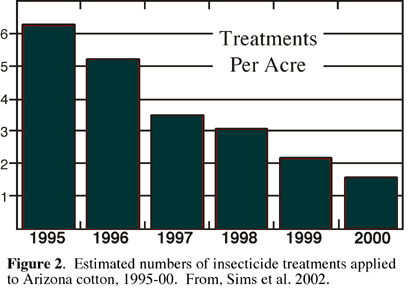Resistance Management | Regulations | Contact Info | Publications | Site Map Bt cotton offers an opportunity to reduce use of pesticides more hazardous than the toxins produced by the Bacillus thuringiensis (Bt) bacterium. What are the risks associated with using it? What are the benefits? Some Potential Positives Reduced pesticide use, leading to
The following table is created from the USDA, National Agricultural Statistics Service data, showing use of pesticides on cotton (both Bt and non-Bt). Since its introduction in 1996, Bt cotton use rapidly grew to 50 to 70% of cotton acreage in Arizona. Its use has coincided with a dramatic downward trend in insecticide use in Arizona cotton (Figure below). However, two new insect growth regulators were also introduced for whitefly control in 1996. Thus, the striking reductions in insecticide use in Arizona cotton since 1995 are attributable to both Bt cotton and the new, selective, whitefly controls.  Another estimate of insecticide use in Bt and non-Bt cotton from 1994 to 2001 can be found at: http://cals.arizona.edu/crops/cotton/insects/cil/btconvcharts.html The methods used in collecting these data differ, Though the numbers do not exactly match, they are in the same range. Some Potential Negatives
Cotton Mainpage | Bt Cotton Mainpage | Background | Why Bt? Resistance Management | Regulations | Contact Info | Publications | Site Map The Department of Entomology College of Agriculture and Life Sciences The University of Arizona Contact: BtCotton@ag.arizona.edu or Al Fournier (fournier@ag.arizona.edu) All contents copyright ©2002. All rights reserved. Last modified November 13, 2003 |

